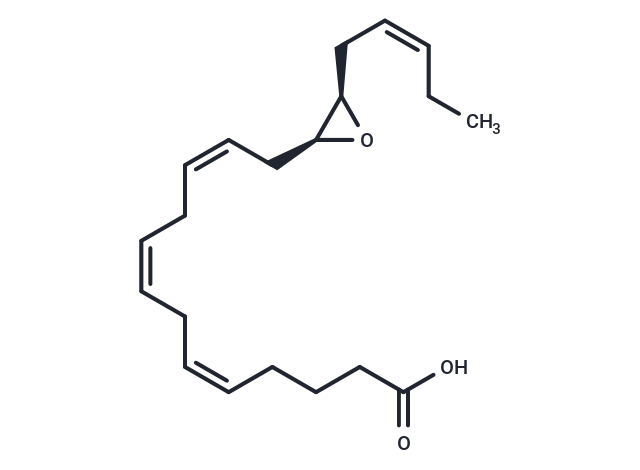Powder: -20°C for 3 years | In solvent: -80°C for 1 year


EDHF (endothelium-derived hyperpolarizing factor) is an unidentified mediator released from vascular endothelial cells in response to acetylcholine and bradykinin which is distinct from the NOS- (nitric oxide) and COX-derived (prostacyclin) vasodilators. Cytochrome P450 (CYP450) metabolism of polyunsaturated fatty acids, produces epoxides such as (±)14(15)-EpETrE which are prime candidates for the actual active mediator. However, the CYP450 metabolites of eicosapentaenoic acid and docosahexaenoic acid have been little studied relative to arachidonate epoxygenase metabolites. (±)14(15)-EpETE is the ω-3 homolog of 14(15)-EpETrE, derived via epoxidation of the 14,15-double bond of EPA. The EDHF activity of (±)14(15)-EpETE has not yet been determined.

| Pack Size | Availability | Price/USD | Quantity |
|---|---|---|---|
| 25 μg | 35 days | $ 120.00 | |
| 50 μg | 35 days | $ 223.00 | |
| 100 μg | 35 days | $ 420.00 | |
| 500 μg | 35 days | $ 1,840.00 |
| Description | EDHF (endothelium-derived hyperpolarizing factor) is an unidentified mediator released from vascular endothelial cells in response to acetylcholine and bradykinin which is distinct from the NOS- (nitric oxide) and COX-derived (prostacyclin) vasodilators. Cytochrome P450 (CYP450) metabolism of polyunsaturated fatty acids, produces epoxides such as (±)14(15)-EpETrE which are prime candidates for the actual active mediator. However, the CYP450 metabolites of eicosapentaenoic acid and docosahexaenoic acid have been little studied relative to arachidonate epoxygenase metabolites. (±)14(15)-EpETE is the ω-3 homolog of 14(15)-EpETrE, derived via epoxidation of the 14,15-double bond of EPA. The EDHF activity of (±)14(15)-EpETE has not yet been determined. |
| Molecular Weight | 318.457 |
| Formula | C20H30O3 |
| CAS No. | 131339-24-7 |
Powder: -20°C for 3 years | In solvent: -80°C for 1 year
DMSO: 50 mg/mL
PBS (pH 7.2): 1 mg/mL
Ethanol: 50 mg/mL
DMF: 50 mg/mL
You can also refer to dose conversion for different animals. More
bottom
Please see Inhibitor Handling Instructions for more frequently ask questions. Topics include: how to prepare stock solutions, how to store products, and cautions on cell-based assays & animal experiments, etc.
(±)14(15)-EpETE 131339-24-7 14(15)-EpETE (±)14(15)EpETE (±)14(15) EpETE inhibitor inhibit
